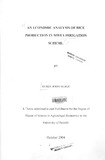| dc.description.abstract | This study aimed at comparing the economics of rice production for two
different groups of farmers in Mwea Irrigation Scheme (MIS). One group is
under the management of Mwea Multi-Purpose Rice Growers (MMRG) and
grows a single crop of rice in a year without rotation. The other group is
composed of the sons and daughters of MMRG tenant farmers and grows a
double crop of rice in a year. It is however not clear which of the two production
systems is efficient or realises higher returns to farmers.
The objectives of the study were: (i) to identify major resources used by
rice farmers and determine which resources significantly influenced rice output,
(ii) to evaluate and compare the technical efficiency levels of both groups of
farmers, (iii) to determine if both groups of farmers were allocating the identified
physical resources efficiently, and (iv) to evaluate and compare the profitability
of rice production in and outside the cooperative society.
A total of 106 farmers were interviewed, 61 being MMRG-dependent and
45 from non-MMRG group. Data collected was fitted to a stochastic frontier
production function model of the Cobb-Douglas type. Regression coefficients
and farm specific technical efficiency levels were estimated using the Maximum
Likelihood Estimate (MLE) teichnique. Efficiency of resource use was evaluated
from the ratios of MVP:MFC.
The results of the study showed that labor, mechanized tractor power,
chemical fertilizer, pesticides, seeds, land and irrigation water significantly
influenced rice output at I% significance level in the MMRG farms. Labor,
however, had a negative coefficient while animal draught power was not
significant in explaining rice output variation even at 10% significance level. For
the non-MMRG farmers, mechanized tractor power, chemical fertilizers,
pesticides, land and irrigation water were all significant at 1% level of
significance while labor and animal draught power were significant at 5% level.
For this group, seed quantity coefficient was not significant even at 10%
significance level. Tractor power, pesticides and irrigation water had negative
coefficients.
The results on technical efficiencies indicated that MMRG dependent
farmers were more technically efficient than MMRG independent farmers, and
there was actually a statistically significant difference in technical efficiency
levels between the single-crop M MRG dependent farmers and t he double-crop
non-MMRG farmers. Further, an analysis of the determinants of technical
efficiency indicated that farmers' specific characteristics e.g. farming experience
(age) and education level as well as institutional factors like access to credit and
extension facilities are important factors in determining the level of technical
efficiency.
The test for allocative efficiency indicated that labor, tractor power,
fertilizer, pesticides and seeds were inefficiently used and only irrigation water
was efficiently used in MMRG dependent farms. For non-MMRG independent
farms, these resources were inefficiently allocated though the seed input was not
statistically significant in explaining rice output variability. Both groups were
found either underutilizing or overutilizing the resources used in rice production.
Gross margin per hectare per year in MMRG dependent farms was Kshs.
42,695.17 and Kshs. 54,653.75 for non-MMRG farms. A test for any statistically
significant difference in the two group's gross margins revealed that they were
statistically different and that rice production under cooperative society is less
profitable than outside the society.
The study thus recommended: One, the Governments should facilitate the
availability of credit and extension services to farmers, two, the research
institutes should undertake a thorough extension exercise to advise all the
Scheme farmers on t he recommended input usage and application rates, three,
there is need for rigorous campaign from the Government, politicians and
development partners aimed at educating the young farmers on the benefits of a
single rice crop in a year, and four, the Government should oversee the revision
and harmonization of MMRG structure of agreement with the Scheme tenants to
avoid exploitation. | en |

